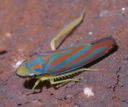Sharpshooters
Cicadellinae
Classification
- Phylum: Arthropoda
- Subphylum: Hexapoda
- Class: Insecta
- Order: Hemiptera
- Suborder: Auchenorrhyncha
- Infraorder: Cicadomorpha
- Superfamily: Membracoidea
- Family: Cicadellidae
- Subfamily: Cicadellinae
Pronunciation
How to pronounce Cicadellinae: /sɪˌkædɛlɪˈnaɪ/
These audio files are automatically generated. While they are not always 100% accurate, they are a good starting point.
Images






Summary
Cicadellinae, commonly known as sharpshooters, are small leafhoppers known for their distinctive feeding habits and contributions to plant health and disease dynamics in ecosystems. They can produce a notable popping sound when expelling excess fluids and have a diverse representation in terms of species and genera.
Physical Characteristics
Sharpshooters have a characteristic ability to expel excess water from their abdomen, producing an audible popping noise during this behavior.
Identification Tips
Look for the distinctive popping sound and examine the structure of the wings and body shape typical of the Cicadellinae.
Habitat
These insects are typically found in various environments where they can feed on plant sap, particularly in vegetation and agricultural areas.
Distribution
There are approximately 160 species in over 30 genera in various regions, with about 2,400 species in around 330 genera recognized worldwide.
Diet
As xylem feeders, sharpshooters feed on plant sap by piercing the plant tissue with their specialized mouthparts.
Life Cycle
The life cycle includes several instars before reaching adulthood, with nymphs predominantly feeding on plant sap.
Reproduction
Reproductive strategies vary among genera, but generally involve laying eggs in plant tissues or in nearby environments.
Predators
Natural predators include various birds, predatory insects, and parasitic organisms.
Ecosystem Role
Sharpshooters play a role in the ecosystem as herbivores and are known to transmit plant diseases due to their feeding habits.
Economic Impact
Some species are known to be agricultural pests, causing damage to crops and plants, impacting agricultural economies.
Collecting Methods
- Netting specimens around host plants
- Using sweep nets in agricultural fields
Preservation Methods
- Ethanol preservation
- Drying and mounting on pins
Evolution
Cicadellinae is closely related to other subfamilies within Cicadellidae, such as Evacanthinae and Signoretiinae, with evolutionary ties to various tribes within Membracoidea.
Similar Taxa
- Evacanthinae
- Signoretiinae
- Amblycephalinae
- Tettigellinae
Misconceptions
While they are known to be pests, not all sharpshooters carry plant pathogens. Their popping sound is often misunderstood by the general public as a threat or disturbance.
Tags
- Cicadellinae
- sharpshooters
- leafhoppers
- Cicadellidae
- Xylem feeders